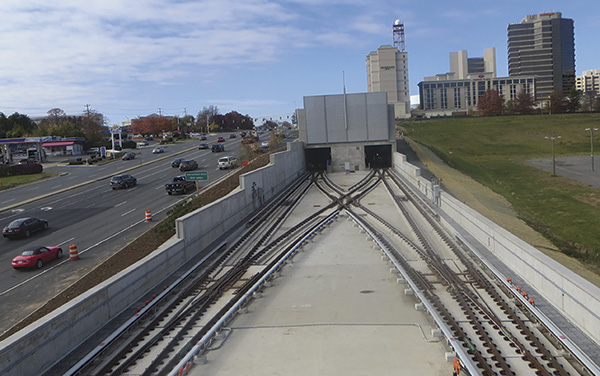
Staying on top of productivity rates and goals is a constant challenge in the construction business. The last thing any construction project manager wants is to have no budget left on a job that is only 85 percent complete.
Traditionally, project managers have used the “percent complete” method to gauge productivity against budget. For example, the foreman in the field walks the job and performs an “eyeball estimate” that the job is X percent complete. Typically, only one cost code is used per system. Too often, this method is little better than throwing darts at a dartboard.
 Shapiro & Duncan installed mechanical systems for the Dulles, Va., Metro Silver Line Extension.
Shapiro & Duncan installed mechanical systems for the Dulles, Va., Metro Silver Line Extension.Shapiro & Duncan Inc. has found a way to get a better handle on productivity rates and goals in relation to project budget. Since January 2012, the company has been using a custom-designed project management software program that not only helps nail down the hours to complete a mechanical project but also provides a toolkit for short interval planning (SIP) and time entry in the field.
To ensure maximum productivity, Shapiro & Duncan starts with estimating software that develops complete material lists and quantified budgets for labor hours and materials required by task. Construction teams use these outputs as a baseline for productivity tracking.
Then, using the custom-designed project management software, the construction management team is able to create a short interval planner (SIP), track productivity and provide weekly production goals. The management team uses SIPs to give the field one week “look-aheads” for the required tasks, which help the crews to stay on budget and on schedule. This software also enables management to communicate clear productivity goals to field crews. Every Friday, the field foreman completes his short interval planning sheet in the software program. This lets the field foreman know by cost code, area and crew size the amount of production units that are required to be installed the following week.
Shapiro & Duncan developed this software program after determining that its construction management teams needed to do a better job of managing labor risk and get a firmer handle on project completion costs.
Making this happen required a fundamental shift in how progress on a project is measured. The old-fashioned “percent complete” method was scrapped in favor of a new “earned hour” method based on the earned value of actual installed quantities. Instead of walking a job and “guesstimating” the percent completed, foremen now report installed quantities of materials by system and area on a daily basis. The software calculates the earned hours based on these actual installed quantities. The program compares the earned hours to budgeted hours, actual hours used and hours at completion. As a result, forecasting and reacting to budget issues happen more quickly.
Turning in spreadsheets and tracking time for 50 or more people can be a big headache on construction projects; however, this software program allows foremen to input daily time reports that are tied to the company payroll system. This prevents duplicate efforts by allowing the payroll department to import daily time into the payroll system and not enter time from time sheets. With this process, management can clearly see the earned value of installed quantities and accurate historical data regarding how many hours it takes to complete each task. This gives project managers a much better handle on how many crew members should work on a particular task. Management can see when employees are not meeting goals and have an opportunity to make the necessary corrections to improve productivity.
The improved transparency provided by the new software program has resulted in better, more proactive project planning and has made cost forecasting more accurate. As a result, productivity on Shapiro & Duncan’s mechanical construction projects has improved dramatically during the nearly two years that the program has been in use.
Now, project crews know what the expectations are in terms of number of crew members and what that crew has to install from week to week. This has improved morale by creating a friendly competition among crews. Teams with the best production rates receive incentives.
The biggest advantage of using this type of software is that it offers more certainty that when the company takes on a new project, the job will be done right and under budget. By setting productivity goals based on the earned value of installed materials, as opposed to completion percentages based on “a hope and a prayer,” the use of this software reduces the likelihood of labor overruns.
